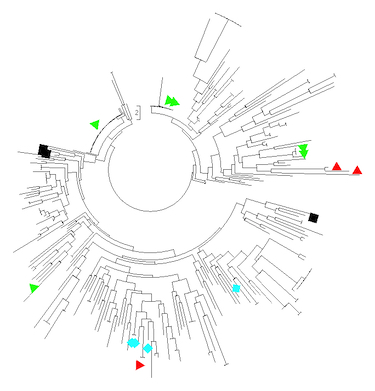What’s in a Name?
A 2017 review of dried flower cannabis material for sale online in a set of North American jurisdictions (Toronto, Vancouver, Denver, WA state, and OR state) turned up 2,739 products for sale under a total of 1,263 “strain names.” (As an aside, in formal biological usage, “strain” is applied to microorganisms and “variety” or “cultivar” is more proper for usage with plants; we’ll use “variety” here for the colloquial “strain”.) As you’d probably guess, some varieties were more popular than others, with Blue Dream being top of the list and only nine names accounting for 10 percent of total material. For either medical or recreational consumers, they know what they like and have expectations of consistency. That’s no more than is expected of hops, grapes, roses, or dog breeds. In fact, just about any plant or animal species which humans have chosen to cultivate and selectively breed varieties of has recognized and meaningfully applied breed or variety names. The difference with cannabis is that there’s never been anyone to hold names accountable, and so there’s possibilities for very different things to be presented under a single variety name.
One obvious way in which this could happen could be an unscrupulous grower or dispensary just willfully renaming whatever they have on hand as something likely to be of higher value based on name. It is, however, equally likely that honest mistakes in handling or labelling of material occurred as it passed from one grower to another, and thus two well intentioned growers could have two different varieties under a common name. Seeds – even those of a relatively inbred variety – can also be legitimately sold under a single name yet resulting plants have significant diversity. Breeders by convention tend to name cross products by conjoining bits of the parental variety names, another legitimate way where two quite different plants might end up with the same name. With these in mind, the following should not be taken as casting aspersions on the ethics of any parties; they’re simply factual observations.
Putting it to the Test – Are Names Reliable?
Are all Sour Diesel, or White Widow, or (insert your favorite here) the same, or at least all closely related? The most direct way to address this is by genetic testing. Processes referred to as DNA fingerprinting can reveal relatedness between any two samples, and family trees (phylogenies) can be inferred under various evolutionary models for larger sets of data. Over the past two years our lab has established and extensively validated one such method for DNA fingerprinting, based on what’s known as VNTR typing. While primarily intended for internal QC purposes, we’ve also processed hundreds of external, commercially available samples by this method, and the results are striking.
In a nutshell, for materials from both the old “gray market” and newer legal supply chain in Canada, there is absolutely no reason to believe that any two cannabis samples bearing the same name are even closely related. Sure, in some cases they’re clonally identical (even when from different producers); sometimes they’re not identical, but they’re genetically very close (more about what that means below); and sometimes they’re wildly different. Lest you think that sticking to a single material from a single producer under a controlled track-and-trace system gives you assurances of reproducibility, the data has included clear cases of a single supplier selling wildly unrelated cannabis varieties under a single name and descriptor, under different lot numbers only a few months apart. The opposite but equally problematic situation is also observed, where a single clone is sold under many different names (we’ve seen more than 10 names applied to a single clone across multiple vendors and years, for example).
It’s the Chemotype that Matters
So what? People don’t take cannabis based on its genotype, but on its chemotypic profile, and it’s the consistency of that which matters. Is variation in genotype actually reflected in chemotype? To address this, we’ve subjected many of our DNA fingerprinted materials to chemotypic analysis covering multiple terpenes and cannabinoids. To date, this data suggests that a single clonal cannabis plant grown by two different producers yields relatively similar material (taking one producer’s material as the baseline, for instance, shows an average of less than 20-percent variation for each of the analytes measured when grown by another producer). Take this to a case of genetically dissimilar materials sold under a single name and the same measure of average chemotypic variation jumps to an eye-popping 160-percent range. Remember, that’s an average – individual analytes including known bioactive terpenes were observed to vary by more than nine times (900 percent) in many cases. As the commonly called ‘entourage effect’ – where a complex mixture of cannabinoids and terpenes has a different biological impact than the major components on their own – has become increasingly supported out of rigorous studies, these wild variances in multiple constituents of the material between two identically named specimens can’t be ignored.
If we’re to conduct meaningful clinical trials, if medical users are to have reliable access to material they’ve self-titrated to meet their needs, and if recreational users want the reliable, same experience every time they get their favorite, it’s time to start making cannabis variety names mean something. Why shouldn’t we have the same controls as the hops, grapes, rose, or dog breeders, on material we’re going to pay good money for, or possibly even trust our health to?
Approaches for Identifying Varieties
If we recognize there’s a problem here that needs solving, the question becomes how. Purely chemotypic analysis isn’t overly practical, as it requires sizable portions of material, is highly dependent on growth parameters and where (and at what stage) plant material is sampled, and the list of potential analytes of significance in differentiating two varieties is extensive. Genotypic analysis by contrast can be done from any plant material at any stage and is both cheap (compared to chemotyping) and readily amenable to automation and high throughput analysis. There are multiple methods for DNA-based genotyping, ranging from cheap, crude methods such as Random Amplification of Polymorphic DNA (RAPD) and Inter Simple Sequence Repeats (ISSR) to high complexity methods like Genotyping by Sequencing (GBS). Between these extremes, the two most common methods are Variable Nucleotide Tandem Repeat (VNTR) and Single Nucleotide Polymorphism (SNP) analyses.
VNTR vs SNP: Key Differences
Each of these has strengths and weaknesses. VNTR is cost effective and fast while providing very good power to resolve even closely related varieties, but is challenging to perform automated data analysis on; SNPs tend to be more costly to develop and less flexible, but also provide excellent variety-resolving power and are relatively easy to automate scoring and data analysis on. Another very significant difference between the methods is the amount of ‘ancillary data’ they may provide the testing lab or anyone seeing the data. Considering the DNA fingerprint name born of analogy, a real fingerprint is a reliable biometric marker identifying an individual but doesn’t tell you the person’s eye or hair color. VNTR methods based on a limited number of genetic loci (points on the genome) and high diversity per locus are much like this, providing identity but unlikely to divulge any additional key genetic information. By contrast, SNP panels consist of large numbers of genetic loci with low per-locus diversity; but the sheer number of loci tagged means there’s a significant chance that a loci and its genetic state as revealed by a SNP assay may disclose “linked traits” such as propensity towards certain chemovar or growth characteristics. Simplistically, if you purely want to identify material and not give away any underlying genetic information, VNTR is probably preferable; if you want to identify material and track linked gene forms (alleles) in breeding programs, SNP has an advantage.
Related: What is Genetic Drift and How Does It Relate to Cloning & Micropropagation?

Setting the Mark: Role of Voucher Specimens
Regardless of method, how would one go about defining varieties of cannabis with DNA fingerprinting, and would this alone be enough to ensure product consistency? Since there are putatively thousands of cannabis varieties in existence by name, the approach would best be one of selection of “voucher specimens” or “type examples” – that is, imagine a plant that some authority (the recognized original breeder of the variety, for instance) puts forward as a reference sample. A DNA fingerprint is taken and establishes a unique, objective identifier against which other material can be tested. Clonal material is easily identified as it provides an identical DNA fingerprint; but what about near relatives? Analysis of DNA fingerprint information allows measurement of closeness of genetic association between two non-identical materials, and over time (and again, with the material being accepted by some authority based on characteristics as belonging to type) it’s possible to define a “genetic space.” Any new material with a genotype falling within that space would generally be considered that variety; any material outside of the space would start to define the genetic space occupied by a new, discrete variety.
Genetics alone, however, isn’t a complete answer in this case. Two plant samples with identical DNA fingerprints have the same genetic potential for a particular chemotypic profile, but will only achieve this when grown and processed similarly. For true assurance of uniformity, both genetic identity and chemotypic analysis of a few key compounds – confirming they are close to expected reference values for the genotype – should be employed. In effect, the chemotype confirms the material has reached its genetic potential, and the few of them examined in this context act as surrogate markers for all the other phytochemicals. If the material is clonal to reference and the (for example) CBD(A) and myrcene levels are very close to expected, the pinene or (fill in the blank) should also be close to reference – without having to extensively test all phytochemicals each time.
Going to the Dogs
If all of this seems confusing, stop for a minute and imagine dogs – in particular, let’s say Dalmatians. We all know what a Dalmatian looks like even though they’re not clonal. They’re a general size and shape, short hair, white with black spots. There are, however, also Dalmatians with brown spots, known as ‘liver Dalmatians.’ These are clearly different than normal Dalmatians, but “the authorities” (in this case, dog breeding associations) still consider them the same breed (variety). Although brown versus black is a clearly obvious difference, it’s been decided that this isn’t a significant difference and thus the two are lumped together under one name. The analogy can and will happen with cannabis, where two closely related but clearly non-identical plants are examined, and a similar judgment call will have to be made – is high versus low linalool, with everything else being about equal, worth calling something a new variety for? As cannabis cultivation becomes mainstream, these are the sorts of decisions calling for the establishment of some sort of “cultivar certification consortium” to provide guidance.
In Conclusion
Establishment of such a cannabis naming convention, with genetic fingerprinting technology as its objective yardstick and paired with an informed consensus selection of reference materials for each variety name, will be no easy task to undertake. It will. however, be in the best interests of all cannabis users regardless of whether that’s for medical or recreational purposes. It will also, in the long run, be in the best interests of growers and breeders, allowing them to clearly establish rights over desirable new varieties. Imagine the utility of being able to say – with proof acceptable to your customers – that you’re growing and selling the latest Cannabis Cup winner; or for a small boutique producer, to be able to back up your claims to possessing a “unique cultivar.” Until such a naming convention is established, the objective truth borne out by testing of marketplace materials is that there’s absolutely zero assurance that your Sour Diesel, Girl Scout Cookies, or any other “strain” as labeled on the package is
at all the same as the same name from somewhere else. It’s time the cannabis industry takes on this challenge, and replaces caveat emptor with consistency and reliability – for everyone’s sake.
Author
-
Dr. John Brunstein is the Chief Scientific Officer at Segra International, a leading micropropagation and tissue culture service for industrial grow operations.






